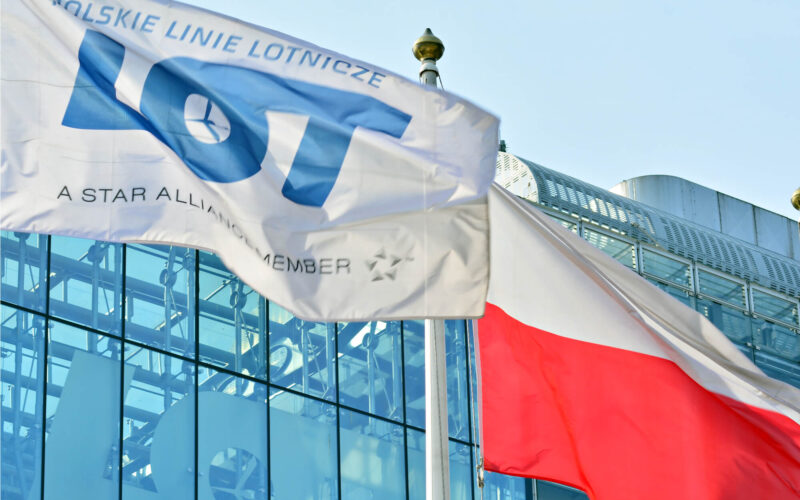Today marks the 93rd anniversary of one of the world’s oldest airlines, a founding member of International Air Transport Association (IATA), and Poland’s flag carrier, LOT Polish Airlines. What began in 1929 as a small fleet has flourished into a globally present international airline, with an impressive network of 75 aircraft serving an incredible 120 destinations.
LOT Airlines was founded in December 1928 when the Polish government took over and merged existing airlines, Aeroflot and Aero. Shortly afterwards, on January 1, 1929, LOT launched operations from Warsaw Chopin Airport, combining a fleet of Fokker F.VII and Junkers F.13 aircraft, flying domestically as well as internationally to destinations such as Vienna and Czerniowce in Ukraine.
By the end of its first year, the company had altered its name to LOT Polish Airlines and had chosen its future logo via a public design competition. The famous flying crane logo is still in use today.
Throughout the 1930s the airline was a pioneer, becoming a founding member of IATA and accepting Douglas and Lockheed aircraft before expanding across Europe to cities, including Bucharest, Berlin and Athens.
In May 1938, LOT crew made an epic experimental transatlantic delivery flight, traveling from Los Angeles to Warsaw in a Lockheed Model 14H. Covering a distance of 24,850km and travelling via South America and Africa, this was the first delivery flight of its kind and took an incredible 85 flying hours.
With the outbreak of the Second World War, much of the airline’s fleet was moved to Romania, but many aircraft did not return. During the war, every single one of LOT’s airport buildings and hangars were destroyed.
In 1945, after the end of the war, LOT was reactivated. The following year saw domestic routes re–established using 10 Li-2 aircraft, which they had received from the military. Soon after, international flights to Berlin, Paris, Stockholm, and Prague were launched using Douglas DC-3 aircraft. As the airline continued to grow, so did its passenger numbers and by 1958 LOT had welcomed its millionth passenger – an impressive milestone. As a result, flights to Moscow were relaunched along with services to London and Zurich, predominantly flying Soviet-made Ilyushin-12B/14s.
The arrival of the Tupolev Tu-132 jet aircraft on November 6, 1968, marked a new chapter for the Polish airline. Notably, these medium-haul aircraft replaced an older, much slower fleet on existing European routes.
The next milestone to conquer, transatlantic routes, commenced following the introduction of long-haul Il-62s. These were the largest aircraft at the time, capable of carrying up to 186 passengers as far as 10,000km. LOT began flying transatlantic to Toronto in 1972 and regular flights to New York City followed in April 1973, before flying east to Bangkok, Bombay (Mumbai) and Dubai later in the decade.
By the beginning of the 1980s, LOT Airlines was to face its next big challenge when political unrest in Poland led to many western airlines halting flights to Warsaw. By December 1981, martial law had been declared in Poland, leading to the grounding of all international flights. The airline would not recover until 1984 when charter services to New York and Chicago resumed.
After the fall of the communist party in 1989, LOT used new freedoms to acquire western aircraft to modernize its fleet and continue expansion. The Boeing 767-200 was introduced in April 1989, followed by the Boeing 767-300. These wide-body aircraft flew from Warsaw to North America and allowed LOT to reposition itself as a major airline, carrying more than 2.3 million passengers over the course of the year.
Throughout the early 1990s, the airline continued to replace older Soviet-era aircraft with newer western aircraft, taking delivery of the French-Italian made ATR-72s as well as Boeing 737s. These were used to expand the route network, adding destinations such as Minsk and Vilnius, before further expansion to Oslo, Frankfurt, and Dusseldorf. By 1994, LOT had agreed on a codeshare with American Airlines (A1G) (AAL) between Warsaw and the United States.
As the 21st century dawned, LOT increased its number of routes significantly, launching Zagreb, Bucharest, and Gatwick. It also received 11 new planes, the company’s largest delivery in the space of a year.
In 2003, the airline became the newest member of Star Alliance, and signed further codeshare agreements with United, BMI and ANA.
Consequently, LOT was able to cement its position as a leading European airline, gaining consecutive industry awards. It became the first airline in the world to fly the Embraer 170 on its Warsaw-Vienna route. In 2014, LOT would become the first airline in Europe to take delivery of the new generation long-haul aircraft, the Boeing 787 Dreamliner.
Another record was broken in 2014, when LOT ran the longest non-stop flight from Chile to Warsaw, a total of 12,000km and 14.5 hours in the air, a record that would stand for six years.
By the end of 2019, LOT Polish Airlines celebrated its 90th year by flying more than 10 million passengers. Unfortunately, as with most airlines, LOT was hit hard by the COVID-19 pandemic and suspended operations in March 2020 for several long months. Now, as LOT Polish Airlines recovers from the global health crisis, I hope to see it return to its pre-pandemic glory and await to see what this iconic airline will do as it approaches its centenary towards the end of this decade. If history is anything to go by, I’m sure it will be bigger and better.

